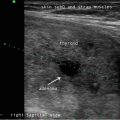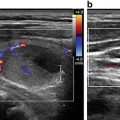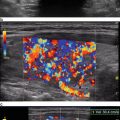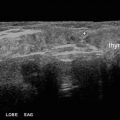© Springer International Publishing Switzerland 2017
Mira Milas, Susan J. Mandel and Jill E. Langer (eds.)Advanced Thyroid and Parathyroid Ultrasound10.1007/978-3-319-44100-9_3939. Ultrasound for Otolaryngologists and Head and Neck Surgeons: What I Learned from Lifetime Practice
(1)
Division of Otolaryngology-HNS, University of Vermont Medical Center, Burlington, VT, USA
(2)
Department of Otolaryngology, Head & Neck Surgery, Veterans Affairs Medical Center-Atlanta, Emory University School of Medicine, 550 Peachtree St NE, Suite 1135, Atlanta, GA 30308, USA
Keywords
OtolarynologistsHead and neck surgeonsUltrasoundRadiology39.1 Pro
39.1.1 Convenience and Efficiency of Patient Care
Imagine the patient who must travel 3–4 h from a small town for an appointment for a suspected thyroid mass. Appropriate imaging and up-to-date cytology are not possible near or within the local community. The receiving physician at our tertiary medical center would perform a standard examination and the patient scheduled for a return visit to radiology for ultrasound. Often, the radiologist will ask the patient to come back yet again for an ultrasound-guided biopsy .
After the cytology is confirmed, a fourth visit to the head and neck surgeon would be required to round out the preoperative program.
Consider the same patient circumstances but availability of office-based ultrasound at the initial visit. Upon receipt of referral with a thyroid mass, the scheduler sets several elements in motion for the initial visit. A complete history and physical are performed along with a complete diagnostic ultrasound of the thyroid and head and neck. An FNA with cytology is accomplished with or without an on-site cytotechnologist. If lymphoma is suspected, an aspirate can be placed in special media at the outset. With thyroid masses, all elements of thyroid surgery are discussed with the patient including risks and complications and consents are signed. The cytology results are reported to the patient and referring physician by telephone in the ensuing week as well as any unexpected changes in surgical management. This scenario is followed with every routine thyroid patient and reduces the patient inconvenience from 4 visits to 1. For head and neck tumor (non-thyroid) patients, the efficiency of obtaining imaging and tissue biopsy at the first visit can translate into reduced time to staging and initiation of treatment. Head and neck cancer patients face many challenges in obtaining multidisciplinary consultations, and point-of-care ultrasound has greatly improved the way I “package” the patient prior to treatment planning.
Stay updated, free articles. Join our Telegram channel

Full access? Get Clinical Tree








